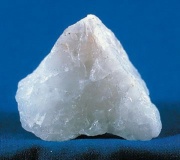Difference between revisions of "Milky quartz"
Jump to navigation
Jump to search
(username removed) |
|||
| (2 intermediate revisions by one other user not shown) | |||
| Line 1: | Line 1: | ||
| + | [[File:SC185935.jpg|thumb|String of Nubian beads<br>MFA# 1991.1130]] | ||
[[File:milkyquartzkes.jpg|thumb|Milky quartz]] | [[File:milkyquartzkes.jpg|thumb|Milky quartz]] | ||
== Description == | == Description == | ||
| − | A cloudy or translucent form of [ | + | A cloudy or translucent form of |
| + | [[quartz|quartz]]. Quartz loses its clarity and becomes cloudy due to the submicroscopic inclusions of air and water. Milky quartz was commonly used for pendants and vessels until the early Dynastic period in Egypt (Aston et al 2000). | ||
== Synonyms and Related Terms == | == Synonyms and Related Terms == | ||
| Line 8: | Line 10: | ||
hydrothermal quartz; milk quartz; snow quartz; cuarzo lechoso (Esp.); quartz laiteux (Fr.); quartzo leitoso (Port.); Milchquarz (Deut.); melkkwarts (Ned.) | hydrothermal quartz; milk quartz; snow quartz; cuarzo lechoso (Esp.); quartz laiteux (Fr.); quartzo leitoso (Port.); Milchquarz (Deut.); melkkwarts (Ned.) | ||
| − | == | + | == Physical and Chemical Properties == |
| − | Trigonal crystal system. Low birefringence. Low thermal expansion. | + | * Trigonal crystal system. |
| − | + | * Low birefringence. | |
| − | Fracture = conchoidal. Luster = vitreous to greasy. Streak = white. | + | * Low thermal expansion. |
| + | * Fracture = conchoidal. | ||
| + | * Luster = vitreous to greasy. | ||
| + | * Streak = white. | ||
{| class="wikitable" | {| class="wikitable" | ||
| Line 23: | Line 28: | ||
|- | |- | ||
! scope="row"| Density | ! scope="row"| Density | ||
| − | | 2.65 | + | | 2.65 g/ml |
|} | |} | ||
| − | == | + | ==Resources and Citations== |
| − | + | * B.Aston, J.Harrell, I.Shaw, "Stone" in ''Ancient Egyptian Materials and Technology'', P.Nicholson, I.Shaw (eds.), Cambridge University Press, 2000, p. 52. | |
| − | B.Aston, J.Harrell, I.Shaw, "Stone" in ''Ancient Egyptian Materials and Technology'', P.Nicholson, I.Shaw (eds.), Cambridge University Press, 2000, p. 52. | ||
| − | |||
| − | |||
* C.W.Chesterman, K.E.Lowe, ''Audubon Society Field Guide to North American Rocks and Minerals'', Alfred A. Knopf, New York, 1979 | * C.W.Chesterman, K.E.Lowe, ''Audubon Society Field Guide to North American Rocks and Minerals'', Alfred A. Knopf, New York, 1979 | ||
| − | + | * Wikipedia: http://en.wikipedia.org/wiki/Milk_quartz (Accessed Sept. 14, 2005) | |
| − | |||
| − | * Wikipedia | ||
[[Category:Materials database]] | [[Category:Materials database]] | ||
Latest revision as of 15:53, 18 October 2022
Description
A cloudy or translucent form of Quartz. Quartz loses its clarity and becomes cloudy due to the submicroscopic inclusions of air and water. Milky quartz was commonly used for pendants and vessels until the early Dynastic period in Egypt (Aston et al 2000).
Synonyms and Related Terms
hydrothermal quartz; milk quartz; snow quartz; cuarzo lechoso (Esp.); quartz laiteux (Fr.); quartzo leitoso (Port.); Milchquarz (Deut.); melkkwarts (Ned.)
Physical and Chemical Properties
- Trigonal crystal system.
- Low birefringence.
- Low thermal expansion.
- Fracture = conchoidal.
- Luster = vitreous to greasy.
- Streak = white.
| Composition | SiO2 |
|---|---|
| Mohs Hardness | 7.0 |
| Density | 2.65 g/ml |
Resources and Citations
- B.Aston, J.Harrell, I.Shaw, "Stone" in Ancient Egyptian Materials and Technology, P.Nicholson, I.Shaw (eds.), Cambridge University Press, 2000, p. 52.
- C.W.Chesterman, K.E.Lowe, Audubon Society Field Guide to North American Rocks and Minerals, Alfred A. Knopf, New York, 1979
- Wikipedia: http://en.wikipedia.org/wiki/Milk_quartz (Accessed Sept. 14, 2005)

